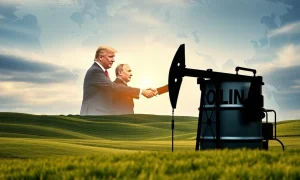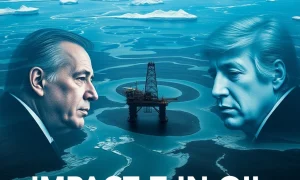As a critical Friday deadline approaches, the global energy market holds its breath. Former President Donald Trump has set a specific date for a Russia-Ukraine cease-fire. This development carries significant implications for **oil prices** worldwide. Businesses and entrepreneurs must understand these potential shifts. The geopolitical landscape often directly influences commodity markets. Therefore, assessing the potential outcomes is vital for strategic planning.
Understanding the Russia-Ukraine Conflict’s Influence on Oil Prices
The conflict between Russia and Ukraine has profoundly impacted global energy markets. Russia, a major oil and gas producer, faces extensive sanctions. Consequently, these measures have disrupted supply chains. They have also altered traditional trade routes. Before the conflict, Russia supplied a significant portion of Europe’s energy needs. The ongoing hostilities continue to create supply uncertainty. This uncertainty often translates into higher **oil prices**.
Moreover, the conflict affects investor sentiment. Traders often react to geopolitical instability by pricing in risk premiums. This means they add an extra cost to oil. They anticipate potential supply disruptions. This speculative element can further drive up prices. The situation remains fluid. Therefore, market participants constantly monitor developments. They seek clarity on future supply availability.
Key factors influencing **oil prices** include:
- Sanctions: Restrictions on Russian oil exports limit global supply.
- Supply Routes: Disruptions to pipelines and shipping lanes increase costs.
- Geopolitical Risk: Heightened tensions add a risk premium to prices.
- Demand Shifts: Economic slowdowns or recoveries can alter consumption patterns.
Trump’s Deadline and Geopolitical Stakes for Oil Prices
Former President Donald Trump recently announced a self-imposed Friday deadline. He stated that if Russia and Ukraine do not reach a cease-fire by then, he will take action. While the specifics of his proposed actions remain unclear, the announcement itself creates ripples. Such a declaration introduces a new layer of geopolitical uncertainty. Markets dislike uncertainty. This situation could lead to increased volatility in **oil prices**.
Trump’s involvement could signify several things. Firstly, it might indicate a renewed push for diplomatic solutions. Secondly, it could suggest potential new pressures on the involved parties. Any action, whether diplomatic or otherwise, carries the potential to alter energy flows. A genuine cease-fire, for instance, might ease supply concerns. Conversely, a failure to meet the deadline could lead to escalation. Escalation typically causes **oil prices** to rise.
Analysts are closely watching this development. They consider various scenarios. The market response will depend heavily on the perceived likelihood of a breakthrough. It also depends on the nature of any proposed ‘action.’ Traders will quickly price in any perceived shift in supply-demand fundamentals. Therefore, this deadline becomes a critical point for energy market forecasts.
Market Scenarios: How Oil Prices Could React
The market anticipates several potential outcomes from Trump’s deadline. Each scenario carries distinct implications for **oil prices**. Understanding these possibilities helps stakeholders prepare. Here, we explore the most likely reactions:
Scenario 1: Cease-fire Achieved
If Russia and Ukraine agree to a cease-fire, this would likely bring immediate relief to markets. A significant reduction in hostilities could signal a path towards normalization. It might also pave the way for easing some sanctions. Consequently, this scenario could lead to increased Russian oil supply reaching global markets. Such an increase would generally put downward pressure on **oil prices**. However, the extent of the price drop would depend on the terms of the cease-fire. It also depends on the speed of sanctions relief. Long-term stability would be the key driver.
Scenario 2: No Cease-fire, Escalation
Failure to meet the deadline, especially if followed by new pressures or intensified conflict, would have the opposite effect. Markets would likely interpret this as a sign of prolonged instability. New sanctions or disruptions to energy infrastructure could further constrain supply. This scenario would almost certainly lead to a sharp increase in **oil prices**. Investors would demand a higher risk premium. Supply concerns would dominate trading. Geopolitical tensions would remain elevated, impacting the broader global economy.
Scenario 3: Prolonged Stalemate
Another possibility is that the deadline passes without a cease-fire or significant escalation. This would mean the current state of affairs largely continues. Markets might see a temporary dip in volatility as the immediate deadline passes. However, the underlying supply-demand imbalances would persist. **Oil prices** would likely remain elevated. They would fluctuate based on minor news developments. This scenario offers no clear resolution. It keeps the market in a state of cautious equilibrium. Small changes could still trigger significant price movements.
Historical Precedents and Future Outlook for Oil Prices
History offers valuable insights into how geopolitical events affect **oil prices**. Past conflicts in the Middle East, for instance, consistently led to price spikes. The 1973 oil crisis and the Gulf War are prime examples. These events demonstrated the vulnerability of global energy supplies. They showed how quickly prices can react to perceived threats. Similarly, the current Russia-Ukraine conflict mirrors these historical patterns. It highlights the importance of energy security.
The future outlook for **oil prices** remains complex. The immediate impact of Trump’s deadline is significant. Yet, several other factors also influence the long-term trend. These include global economic growth, the pace of the energy transition, and OPEC+ production decisions. A global economic slowdown could dampen demand. Conversely, robust growth could push prices higher. The shift towards renewable energy also plays a role. It affects long-term investment in fossil fuels. This can influence future supply capabilities.
Furthermore, the strategic energy policies of major nations matter. Countries like the United States often release oil from strategic reserves. They do this to stabilize markets during crises. Such actions can temporarily alleviate upward price pressure. However, they do not address underlying supply deficits. The overall trend will depend on a delicate balance. It balances geopolitical stability, economic health, and energy policy.
Key Players and Their Impact on Global Oil Prices
Several key players significantly influence global **oil prices**. Their actions, policies, and decisions can shift market dynamics. Understanding their roles is essential for predicting future trends. Here are some of the most influential entities:
OPEC+ Alliance
The Organization of the Petroleum Exporting Countries (OPEC) and its allies, known as OPEC+, control a large share of global oil production. Their decisions on output levels directly impact supply. If OPEC+ decides to cut production, **oil prices** often rise. Conversely, an increase in production can lead to price drops. The alliance’s unity and adherence to quotas are critical. Recent meetings have focused on market stability. They have aimed to balance supply with global demand. Their next moves will be closely watched.
United States
The United States is both a major consumer and producer of oil. Its domestic shale oil production has transformed global energy markets. US energy policy also plays a significant role. Sanctions, trade agreements, and strategic reserve releases all affect **oil prices**. The Biden administration’s approach to energy security and its stance on the Russia-Ukraine conflict are particularly relevant. US diplomatic efforts can also influence geopolitical stability, which then affects oil markets.
Russia
As one of the world’s largest oil and gas exporters, Russia’s production and export capabilities are paramount. The ongoing conflict and associated sanctions severely impact its ability to sell oil. Any changes to these sanctions or to Russia’s production capacity directly influence global supply. This, in turn, affects **oil prices**. Russia’s energy strategy often intertwines with its foreign policy. This adds another layer of complexity for market analysis.
China and India
These two nations represent massive energy consumers. Their economic growth directly translates into demand for oil. China’s post-pandemic recovery, for instance, significantly impacts global demand forecasts. India’s growing industrial base also requires substantial energy imports. Their purchasing decisions, especially regarding discounted Russian oil, can reshape trade flows. Therefore, the economic health and energy policies of China and India are crucial for the future direction of **oil prices**.
In conclusion, the looming Friday deadline for a Russia-Ukraine cease-fire is a pivotal moment for global **oil prices**. The outcome will shape short-term market volatility and potentially influence long-term energy trends. Geopolitical events continue to demonstrate their profound impact on commodity markets. Therefore, staying informed and adapting to these shifts remains essential for all market participants.
Frequently Asked Questions (FAQs)
1. How does the Russia-Ukraine conflict affect global oil prices?
The conflict affects global **oil prices** by disrupting supply from Russia, a major producer. Sanctions limit exports, creating uncertainty and driving up prices due to perceived scarcity. Shipping routes and insurance costs also increase.
2. What is Trump’s deadline for a Russia-Ukraine cease-fire?
Former President Donald Trump has set a self-imposed Friday deadline. He stated that if Russia and Ukraine do not reach a cease-fire by then, he will take unspecified actions. This announcement introduces new geopolitical pressure.
3. What are the potential scenarios for oil prices if a cease-fire is reached?
If a cease-fire is reached, **oil prices** would likely decrease. This is because market uncertainty would lessen, and potential sanctions relief could increase Russian oil supply. However, the exact impact depends on the cease-fire’s terms.
4. How would oil prices react if the deadline passes without a cease-fire?
If the deadline passes without a cease-fire, **oil prices** would likely rise. This scenario suggests continued or escalated conflict, further supply disruptions, and increased geopolitical risk premiums. This maintains market volatility.
5. What role do OPEC+ countries play in influencing oil prices?
OPEC+ countries, including major oil producers, collectively decide on production levels. Their decisions to increase or decrease output directly impact global supply. This, in turn, significantly influences global **oil prices**.
6. Why is geopolitical stability important for oil prices?
Geopolitical stability is crucial for **oil prices** because instability creates supply risks. Conflicts can disrupt production, transport, and trade routes. This leads to higher risk premiums and increased volatility in the market.
























